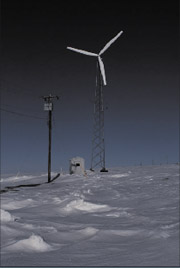
Natural Resources Canada > Earth Sciences Sector > Priorities > Climate Change Impacts and Adaptation > Climate Change in Canada
Taking the Chill Off: Climate Change in the Yukon and Northwest Territories How are N.W.T. and Yukon Responding to Climate Change?
In 1995, Canada produced 619,000,000 tonnes of CO2. The western Arctic produces a very small amount of this but its climate is affected by emissions from the rest of the world. Although Yukon and N.W.T. are small contributors to global emissions, much is being done in these territories to reduce emissions. For example, an N.W.T. Greenhouse Gas Strategy is under development. Representatives of business, industry, aboriginal, government and environmental organizations are working together to develop a strategy to effectively manage greenhouse gas emissions.
Alternate energy sources are being used to replace diesel fuel generators. Examples include:
- Solar Panels at the Aurora Research Institute
- Photovoltaics
- Solar Wall in Fort Smith
- Waste Heat Recovery in Holman
- Wind Turbines in Sachs Harbour, N.W.T. and Whitehorse, Yukon
These measures save money as well as reducing greenhouse gas emissions.

Solar panels at the Aurora Research Institute |

Solar powered Telecom site in Nahani National Park
((Source: CANMET, Natural Resources Canada)) |
Research and Education
- Northern Climate Exchange is a Yukon based centre for climate change research and education in the circumpolar north.
- Community based monitoring programs such as the Arctic Borderlands Ecological Knowledge Society
- University and other research programs

Wind Turbine |
Things YOU can do to reduce greenhouse gas emissions, save energy and money.
- Buy a fuel efficient car
- Use the car less
- Turn the car off instead of idling it
- Use an energy efficient furnace
- Increase insulation in your home
The following provide more information on reduction of greenhouse gas emissions and alternate energy sources:
- Yukon Development Corporation
- The Yukon Green Power Initiative
- Northern Climate Exchange: Northern Climate Exchange
- N.W.T. Greenhouse Gas Strategy Development Process
| 